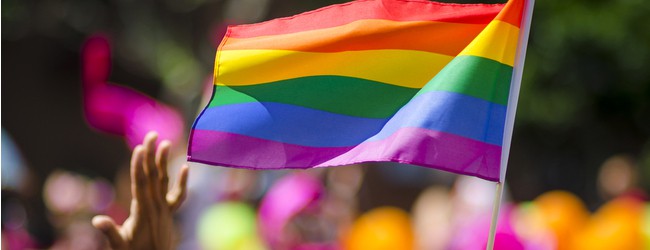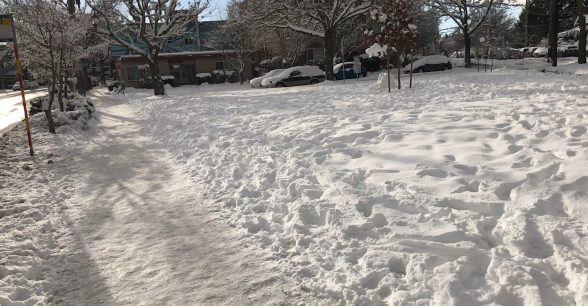It’s Time for LGBQTIA+ Communities to Celebrate Disabled People
LGBQTIA+ spaces are supposed to be environments where we can be our true, authentic selves without stress. Where we can revel in being surrounded by our people, feeling safe and at home; places of queer joy, shared rage and frustration, commiseration, co-conspiracy.
But for many multiply marginalized LGBQTIA+ people, that’s not the case. Instead, these spaces can become acute reminders of outsider status, whether someone is a queer Muslim who encounters Islamophobic attitudes or a Black woman challenging the inclusion of police in Pride celebrations. Some LGBQTIA+ members of the disability community experience similar frustrations, feeling excluded both physically and emotionally from spaces that claim to be welcoming to all.
“I constantly have to talk about this. I’m not allowed to just relax, almost anywhere, anymore…I am not a priority. People like me never are,” says Noor Pervez, a community organizer and activist who feels exclusion in queer spaces, disability spaces, and Muslim spaces alike.
The issue of physical access often makes people think of wheelchair users and accommodations like ramps, wide doorways, grab bars in bathrooms, and conscientious room layout to make sure they can enter and move freely. But physical accessibility runs deeper than this, encompassing people with a variety of mobility impairments as well as people sensitive to light and sound and those with other access needs. Pervez says “access isn’t some frilly excess thing,” but it’s often treated like one.
“Before it shut down the local LGBT Center was not accessible at all — the entrance had I believe five steps to get up. Many important meetings and events, as well as the biggest queer library in town, were held here,” says Rain Chamberlain, who has experienced a litany of access issues. This trend, of queer student centers, community gathering spots, and similar locales being located up stairs or in buildings without elevators, repeats itself across the United States. It’s hard to feel welcome when you can’t get in the door.
Emotional access is something slightly different. In a perfectly physically accessible place, it’s still possible to feel deeply emotionally unwelcome. Maybe that comes in the form of disablist rhetoric from people giving speeches and presentations, or prejudiced comments from people in the room. Liz Moore, a disabled activist, has a vivid memory of attending a DC Dyke March where a presenter refused to speak without an ASL interpreter: “I remember the crowd getting restless: wanting the speech to start, wanting the March to start, wanting to be out of the heat. There were a lot of questions about why we were waiting, and probably a lot of ignorant questions about ASL and Deaf culture.”
Pride month is a particularly apt time to think about how to include members of the disability community more proactively in LGBQTIA+ spaces, but as a reminder, this is an issue that persists long after the confetti has been cleared from the streets. If your favorite hangouts, events, and organizations don’t include visibly disabled people or people who identify as having invisible disabilities, ask yourself why not, and what you can do about it. Conscious disability inclusion is an ever-evolving activity and something that everyone — including disabled people — needs to work on continuously.
Disability awareness consultant and podcaster Andrew Gurza is acutely familiar with a sense of exclusion in queer spaces, where he sometimes encounters pitying looks or is told to leave the dancefloor because his wheelchair is “in the way” in the eyes of nondisabled attendees. “I think we are excluded from queerness; in our parades, in our clubs and in our vision of sex, and that hurts. More so than being excluded on the basis of physical access alone, being excluded emotionally is one of the hardest parts about being a queer cripple.”
Maggie Tiede expresses frustration with another pressing issue the LGBQTIA+ community struggles to deal with: The lack of options for events for people who can’t be out late, go to bars, and engage in other activities that assume a child-free, youthful, nondisabled status on the part of participants. “The fact that the only alternatives that seem to get organized to a racist and overly commercialized Pride are intense, late-night, substance-heavy theatre events is frustrating!” For LGBQTIA+ people who want more family-friendly options, daytime entertainment, or queer events where substance use and highly stimulating environments aren’t the norm, it can be hard to connect with the community. “I actually feel like I don’t know where the queers are gathering in my city, just a subset of disabled queers and allies,” comments Moore.
It doesn’t have to be this way. Pervez has fond memories of disability-inclusive radical queer spaces “back home,” for example. It’s possible to build such spaces, with disabled people in leadership and with a leadership that isn’t uniformly white and cis, either. Using access checklists and recruiting disabled leadership from the start can radically improve physical and emotional access alike, just as explicitly including disability in codes of conduct and anti-harassment policies can make it clear that event organizers affirm disability as a marginalization and will not tolerate abuse of disabled attendees and participants.
But to do so, the LGBQTIA+ community needs to acknowledge that there are cripples among them. Given that LGBQTIA+ people are more likely to be disabled and less likely to be able to access adequate health care, this is not a hypothetical: Disability inclusion is LGBQTIA+ justice, because disability rights are deeply connected with the struggle for LGBQTIA+ liberation. Are queer spaces ready for the radical step of admitting that disabled people belong among them, and in fact have experience, skills, and thoughts that can further the cause?
About Rooted In Rights
Rooted in Rights exists to amplify the perspectives of the disability community. Blog posts and storyteller videos that we publish and content we re-share on social media do not necessarily reflect the opinions or values of Rooted in Rights nor indicate an endorsement of a program or service by Rooted in Rights. We respect and aim to reflect the diversity of opinions and experiences of the disability community. Rooted in Rights seeks to highlight discussions, not direct them. Learn more about Rooted In Rights



